A New Correlation for Single-Sided Natural Ventilation Rate Based on Full-Scale Experimental Study in Mogao Grottoes, Dunhuang, China
Abstract
:1. Introduction
2. Materials and Methods
2.1. Review of Existing Correlations for Single-Sided Ventilation Rates
2.2. Experimental Methods
2.2.1. Meteorological Parameters Outside the Caves
2.2.2. Temperature Inside the Caves
2.2.3. Wind Pressure Coefficient
2.2.4. Natural Ventilation Rate
3. Results
3.1. Analysis of Experimental Results
3.2. Evaluation of Existing Correlations
3.3. New Correlation
3.4. Correlation Verification
4. Discussion
4.1. Comparisons with Existing Correlations
4.2. Stability Analysis
4.2.1. Temperature Inside and Outside the Cave
4.2.2. Wind Direction Outside the Cave
4.3. Verification of Cave 328
5. Conclusions
- 1.
- A correlation is established for calculating natural ventilation rates in cave sites, which considers wind-driven, buoyancy-driven and fluctuation-driven effects. The correlation is verified by comparison with measured data and shows an average deviation of 16.35%, a maximum deviation of 18.92% and a minimum deviation of 11.22% for eight experimental cases.
- 2.
- Our correlation is found to be more accurate than eight other existing correlations selected from the literature, with average deviations ranging from 17.85% to 59.39%. Our correlation outperforms other correlations in predicting natural ventilation rates of caves, and its reliability is demonstrated through consistent and small deviations across individual cases.
- 3.
- Our correlation has the advantage of reducing the impact of temperature differences, wind speeds and wind direction changes on natural ventilation rates. The deviations in ventilation rates under different temperature differences and wind directions are only 2.46% and 5.08%, respectively.
- 4.
- Our correlation is applicable to other types and sizes of caves, as demonstrated by the 22.46% deviation obtained between the results calculated using our correlation and the measured natural ventilation rates in Cave 328. This suggests that our correlation has high popularization value.
Author Contributions
Funding
Data Availability Statement
Acknowledgments
Conflicts of Interest
References
- Fan, J.S. The protection and management of the Mogao Grottoes in Dunhuang. Dunhuang Res. 2000, 1, 1–9. [Google Scholar]
- Li, Z.X. The protection of the Dunhuang Grottoes and its tasks. Dunhuang Res. 2000, 1, 10–23. [Google Scholar]
- Yang, S.L.; Wang, X.D.; Guo, Q.L.; Zhao, L.Y.; Lin, Q.T. Preliminary analysis of moisture distribution in cliff rocks of the Mogao Grottoes in Dunhuang. Hydrogeol. Eng. Geol. 2009, 36, 94–97. [Google Scholar]
- Wang, J.L.; Yan, Z.F.; Wang, X.D.; Zhang, Z.M.; Shang, R.H.; Bi, W.B. Experimental research on mechanical ventilation system for Cave 328 in Mogao Grottoes, Dunhuang, China. Energy Build. 2016, 130, 692–696. [Google Scholar] [CrossRef]
- Wang, J.L.; Yan, Z.F.; Wang, X.D.; Zhang, Z.M.; Shang, R.H.; Xu, J.T.; Gao, W.Q. Test research on the natural ventilation of the Mogao Grottoes. Dunhuang Res. 2015, 4, 121–126. [Google Scholar]
- Wang, J.L.; Yan, Z.F.; Wang, X.D.; Zhang, Z.M.; Shang, R.H.; Bi, W.B. Experimental research on natural ventilation of the Mogao Grottoes in Dunhuang. Xi’an Univ. Arch. Technol. 2015, 47, 712–716. [Google Scholar]
- Li, Z.X. Sixty years of the Dunhuang Grottoes protection. Dunhuang Res. 2004, 3, 10–26. [Google Scholar]
- Wang, Y.J.; Zhang, Y.J.; Guo, Q.L.; Yang, S.L.; Zhang, G.B. Characteristics of temperature and relative humidity of Cave 87 in Mogao Grottoes. J. Lanzhou Univ. 2014, 50, 1–6. [Google Scholar]
- Guo, J.; Zheng, Q.P.; Zhang, C.T. The Design and CFD Simulation of the Mogao Grottoes Micro Environment Control System. Discuss. Commun. 2015, 4, 27–30. [Google Scholar]
- Wang, J.L.; Yan, Z.F. The environmental control equipment system of the Mogao Caves under heavy rainfall. Archit. Cult. 2014, 3, 58–62. [Google Scholar]
- Zhong, W.Z.; Xiao, W.; Zhang, T. Numerical Investigations on Natural Ventilation in Atria of China’s Southern Yangtze Vernacular Dwellings. Sustain. Cities Soc. 2023, 89, 104341. [Google Scholar] [CrossRef]
- Ziarani, N.N.; Cook, M.J.; Freidooni, F.; O’Sullivan, P.D. The role of near-façade flow in wind-dominant single-sided natural ventilation for an isolated three-storey building: An LES study. Build. Environ. 2023, 235, 110210. [Google Scholar] [CrossRef]
- Xie, M.J.; Wang, Y.R.; Liu, Z.X.; Zhang, G.Q. Effect of the location pattern of rural residential buildings on natural ventilation in mountainous terrain of central China. J. Clean. Prod. 2022, 340, 130837. [Google Scholar] [CrossRef]
- Yi, Y.K.; Anis, M.; Jang, K.; Kim, Y.J. Application of machine learning (ML) and genetic algorithm (GA) to optimize window wing wall design for natural ventilation. J. Build. Eng. 2023, 68, 106218. [Google Scholar] [CrossRef]
- Li, H.; Li, A.; Hou, Y.C.; Zhang, C.; Guo, J.N.; Li, J.X.; Ma, Y.Q.; Wang, T.Q.; Yin, Y.F. Analysis of Heat and Humidity in Single-Slope Greenhouses with Natural Ventilation. Buildings 2023, 13, 606. [Google Scholar] [CrossRef]
- de la Hoz-Torres, M.L.; Aguilar, A.J.; Costa, N.; Arezes, P.; Ruiz, D.P.; Martinez-Aires, M.D. Predictive Model of Clothing Insulation in Naturally Ventilated Educational Buildings. Buildings 2023, 13, 1002. [Google Scholar] [CrossRef]
- Bramiana, C.N.; Aminuddin, A.M.R.; Ismail, M.A.; Widiastuti, R.; Pramesti, P.U. The Effect of Window Placement on Natural Ventilation Capability in a Jakarta High-Rise Building Unit. Buildings 2023, 13, 1141. [Google Scholar] [CrossRef]
- Surendran, V.M.; Irulappan, C.; Jeyasingh, V.; Ramalingam, V. Thermal Performance Assessment of Envelope Retrofits for Existing School Buildings in a Hot–Humid Climate: A Case Study in Chennai, India. Buildings 2023, 13, 1103. [Google Scholar] [CrossRef]
- Austin, M.C.; Bouzouidja, R.; Bruneau, D.; Sempey, A.; Wu, T.T.V.; Mora, L. Experimental Evidence of the Coupling between the Energy Charge–Discharge and Natural Ventilation in a Full-Scale Passive Building. Buildings 2023, 13, 632. [Google Scholar] [CrossRef]
- Zoure, A.N.; Genovese, P.V. Implementing natural ventilation and daylighting strategies for thermal comfort and energy efficiency in office buildings in Burkina Faso. Energy Rep. 2023, 9, 3319–3342. [Google Scholar] [CrossRef]
- Chu, C.-R.; Su, Z.-Y. Natural ventilation design for underground parking garages. Build. Environ. 2023, 227, 109784. [Google Scholar] [CrossRef]
- Li, C.; Chen, Y. A multi-factor optimization method based on thermal comfort for building energy performance with natural ventilation. Energy Build. 2023, 285, 112893. [Google Scholar] [CrossRef]
- Sung, H.J.; Kim, S.H.; Kim, H. Analysis of Building Retrofit, Ventilation, and Filtration Measures for Indoor Air Quality in a Real School Context: A Case Study in Korea. Buildings 2023, 13, 1033. [Google Scholar] [CrossRef]
- Li, L.S.; Du, J.G.; Liu, H.L.; Chen, R.H.; Liu, T. Dynamic characteristics and seismic responses of painted sculptures of Dunhuang Mogao Grottoes. J. Cult. Herit. 2016, 22, 1040–1048. [Google Scholar] [CrossRef]
- Liu, B.L.; Peng, W.Y.; Li, H.D.; Qu, J. Increase of moisture content in Mogao Grottoes from artificial sources based on numerical simulations. J. Cult. Herit. 2020, 45, 135–141. [Google Scholar] [CrossRef]
- Bi, W.B.; Yan, Z.F.; Zhang, Z.M.; Yao, S.S.; Zhang, J.J.; Wang, X.D. Modeling and numerical simulation of heat and mass transfer in the cave wall of the Mogao Grottoes in China. Build. Environ. 2021, 201, 108003. [Google Scholar] [CrossRef]
- Yao, S.S.; Yan, Z.F.; Ma, Q.; Xu, B.K.; Zhang, Z.M.; Bi, W.B.; Zhang, J.J. Analysis of the annual hygrothermal environment in the Maijishan Grottoes by field measurements and numerical simulations. Build. Environ. 2022, 221, 109229. [Google Scholar] [CrossRef]
- Zhang, G.B.; Wang, W.F.; Xu, P.; Qianchuan, X.; Hou, W.F.; Zhang, Z.M. Comparative analysis of air exchange rate in typical caves of the Mogao Grottoes in Dunhuang. Dunhuang Res. 2009, 6, 100–104. [Google Scholar]
- Zhang, J.J. Study on Key Technical Parameters of Mechanical Ventilation of the Mogao Grottoes in Dunhuang; Xi’an University of Architecture and Technology: Xi’an, China, 2017. [Google Scholar]
- Warren, P.R. Ventilation through openings on one wall only. In International Centre for Heat and Mass Transfer Seminar “Energy Conservation in Heating, Cooling, and Ventilating Buildings”; Hemisphere: New York, NY, USA, 1977. [Google Scholar]
- Warren, P.R.; Parkins, L.M. Window-opening behaviour in office buildings. Build. Serv. Eng. Res. Technol. 1984, 5, 89–101. [Google Scholar] [CrossRef]
- Dascalaki, E.; Santamouris, M.; Argiriou, A.; Helmis, C.; Asimakopoulos, D.N.; Papadopoulos, K.; Soilemes, A. On the combination of air velocity and flow measurements in single sided natural ventilation configurations. Energy Build. 1996, 24, 155–165. [Google Scholar] [CrossRef]
- Dascalaki, E.; Santamouris, M.; Asimakopoulos, D.N. On the use of deterministic and intelligent techniques to predict the air velocity distribution on external openings in single-sided natural ventilation configurations. Sol. Energy 1999, 66, 223–243. [Google Scholar] [CrossRef]
- Phaff, H.; Gids, W.D. Ventilation rates and energy consumption due to open windows: A brief overview of research in the Netherlands. Air Infiltration Rev. 1982, 4, 4–5. [Google Scholar]
- Larsen, T.S.; Heiselberg, P. Single-sided natural ventilation driven by wind pressure and temperature difference. Energy Build. 2008, 40, 1031–1040. [Google Scholar] [CrossRef]
- Larsen, T.S.; Tine, S.; Heiselberg, P.; Sawachi, T. Analysis and Design of Single-Sided Natural Ventilation. In Proceedings of the 4th International Symposium on HVAC, Beijing, China, 9–11 October 2003; pp. 159–163. [Google Scholar]
- Caciolo, M.; Cui, S.Q.; Stabat, P.; Marchio, D. Development of a new correlation for single-sided natural ventilation adapted to leeward conditions. Energy Build. 2013, 60, 372–382. [Google Scholar] [CrossRef]
- Caciolo, M.; Stabat, P.; Marchio, D. Full scale experimental study of single-sided ventilation: Analysis of stack and wind effects. Energy Build. 2011, 43, 1765–1773. [Google Scholar] [CrossRef]
- Pan, W.X.; Liu, S.M.; Li, S.S.; Cheng, X.L.; Zhang, H.; Long, Z.W.; Zhang, T.F.; Chen, Q.Y. A model for calculating single-sided natural ventilation rate in an urban residential apartment. Build. Environ. 2019, 147, 372–381. [Google Scholar] [CrossRef]
- Tang, Y.Q.; Li, X.F.; Zhu, W.M.J.; Cheng, P.L. Predicting single-sided airflow rates based on primary school experimental study. Build. Environ. 2016, 98, 71–79. [Google Scholar] [CrossRef]
- Sun, X.Y.; Yu, R.T.; Wu, Y. Investigation on wind tunnel experiments of ridge-valley tensile membrane structures. Eng. Struct. 2019, 187, 280–298. [Google Scholar] [CrossRef]
- Buratti, C.; Mariani, R.; Moretti, E. Mean age of air in a naturally ventilated office: Experimental data and simulations. Energy Build. 2011, 43, 2021–2027. [Google Scholar] [CrossRef]
- Cui, S.Q.; Cohen, M.; Stabat, P.; Marchio, D. CO2 tracer gas concentration decay method for measuring air change rate. Build. Environ. 2015, 84, 162–169. [Google Scholar] [CrossRef]
- Meiss, A.; Feijó-Muñoz, J.; García-Fuentes, M.A. Age-of-the-air in rooms according to the environmental condition of temperature: A case study. Energy Build. 2013, 67, 88–96. [Google Scholar] [CrossRef]
- Sherman, M.H. Tracer-gas techniques for measuring ventilation in a single zone. Build. Environ. 1990, 25, 365–374. [Google Scholar] [CrossRef]
- Dai, X.L.; Liu, J.J.; Yin, Y.H.; Song, X.; Jia, S.S. Modeling and controlling indoor formaldehyde concentrations in apartments: On-site investigation in all climate zones of China. Build. Environ. 2018, 127, 98–106. [Google Scholar] [CrossRef]
- Li, X.T.; Wang, X.; Li, X.F.; Zhu, Y.X. Study on air age in ventilated room by tracer gas method. HVAC 2001, 31, 79–81. [Google Scholar]
- Wang, J.L. Research on the Technology of Ventilation Regulation of the Mogao Grottoes in Dunhuang; Xi’an University of Architecture and Technology: Xi’an, China, 2016. [Google Scholar]
- Liu, S.M.; Pan, W.X.; Zhang, H.; Cheng, X.L.; Long, Z.W.; Chen, Q.Y. CFD simulations of wind distribution in an urban community with a full-scale geometrical model. Build. Environ. 2017, 117, 11–23. [Google Scholar] [CrossRef]
- Counihan, J. Adiabatic atmospheric boundary layers a review and analysis of data from the period 1880–1972. Atmos. Environ. 1975, 9, 871–905. [Google Scholar] [CrossRef]
- Heiselberg, P.; Svidt, K.; Nielsen, P.V. Characteristics of airflow from open windows. Build. Environ. 2001, 36, 859–869. [Google Scholar] [CrossRef]
- Li, Y.G. Buoyancy-driven natural ventilation in a thermally stratified one-zone building. Build. Environ. 2000, 35, 207–214. [Google Scholar] [CrossRef]
- ASHRAE 62.1-2022; Ventilation and Acceptable Indoor Air Quality. ANSI/ASHRAE: Peachtree Corners, GA, USA, 2022.
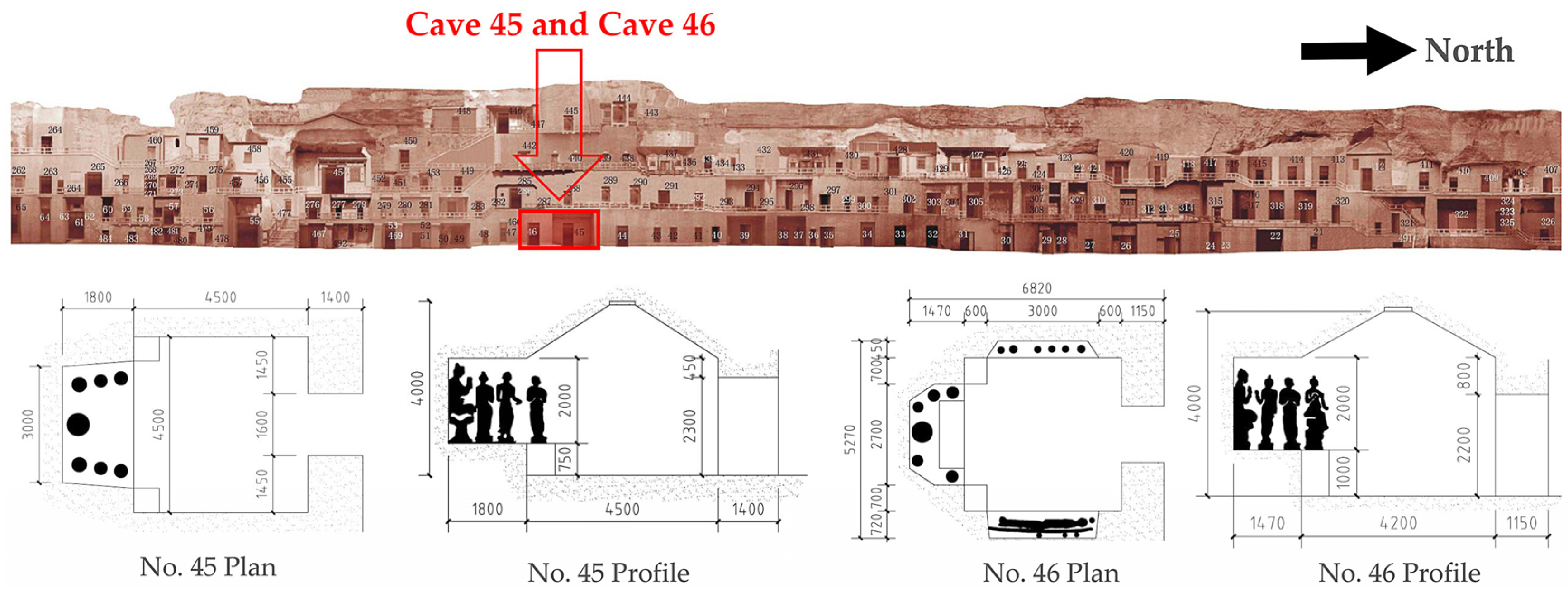


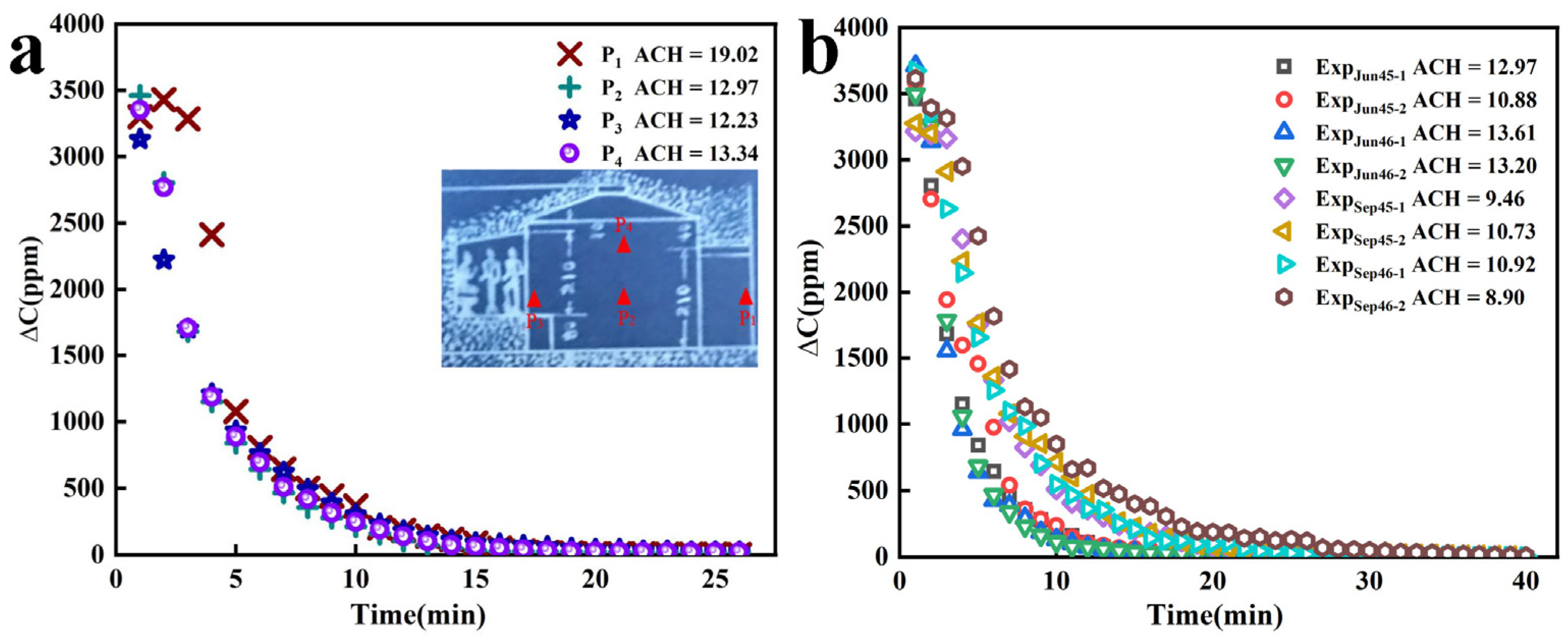
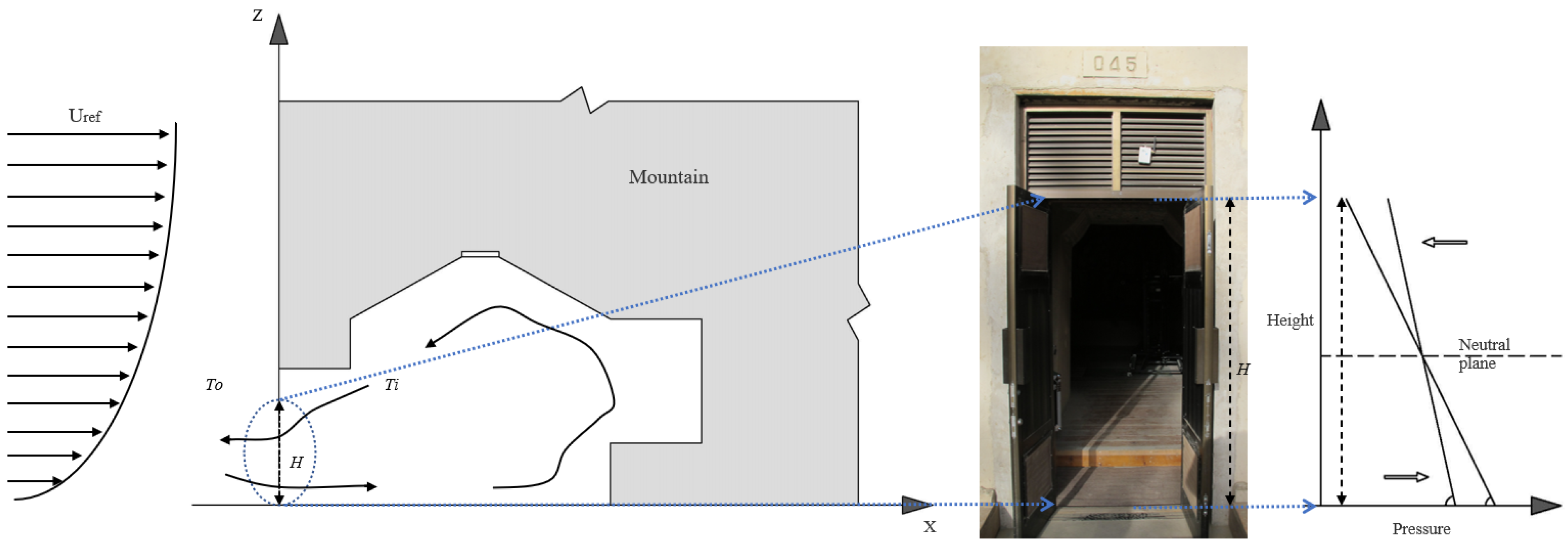



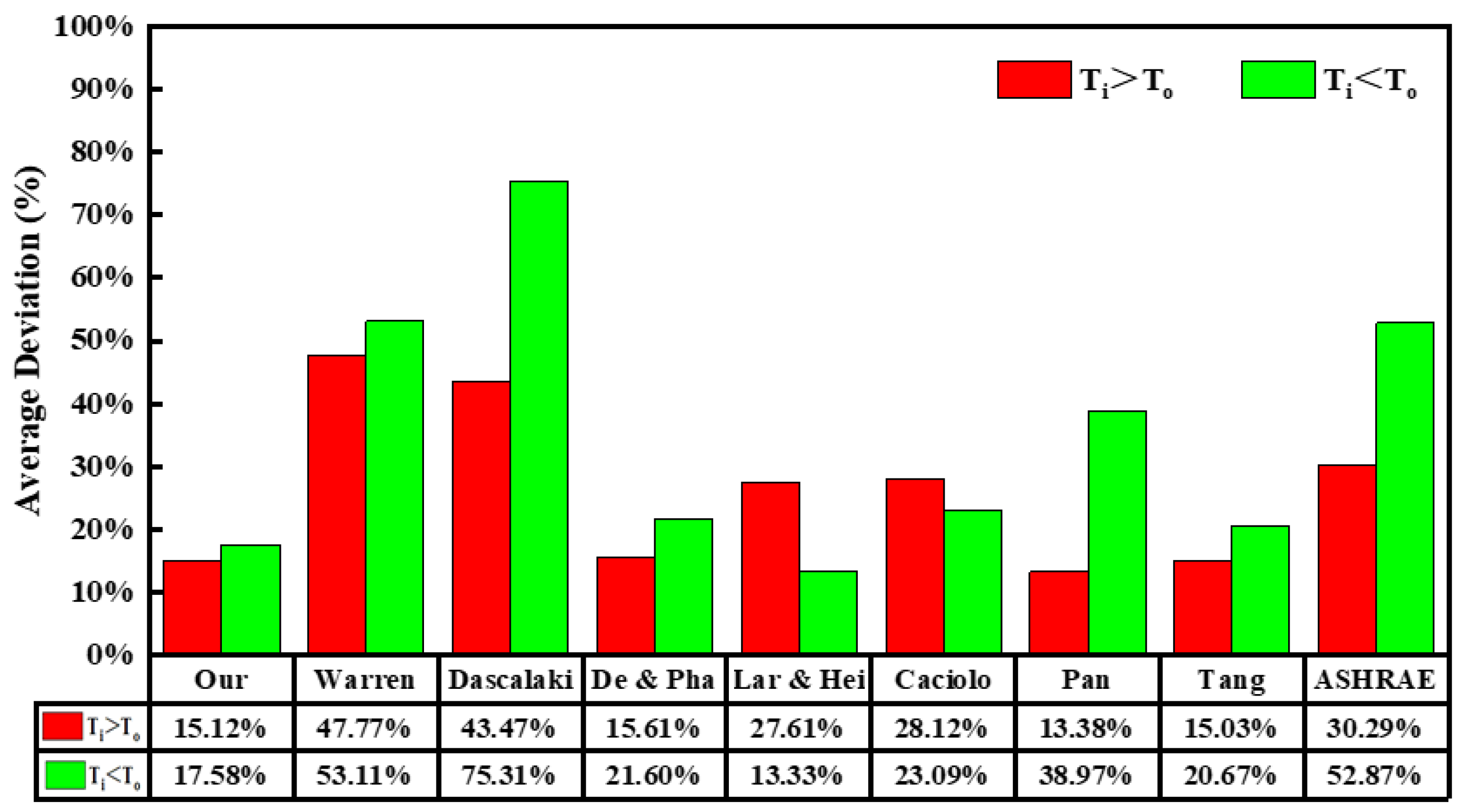
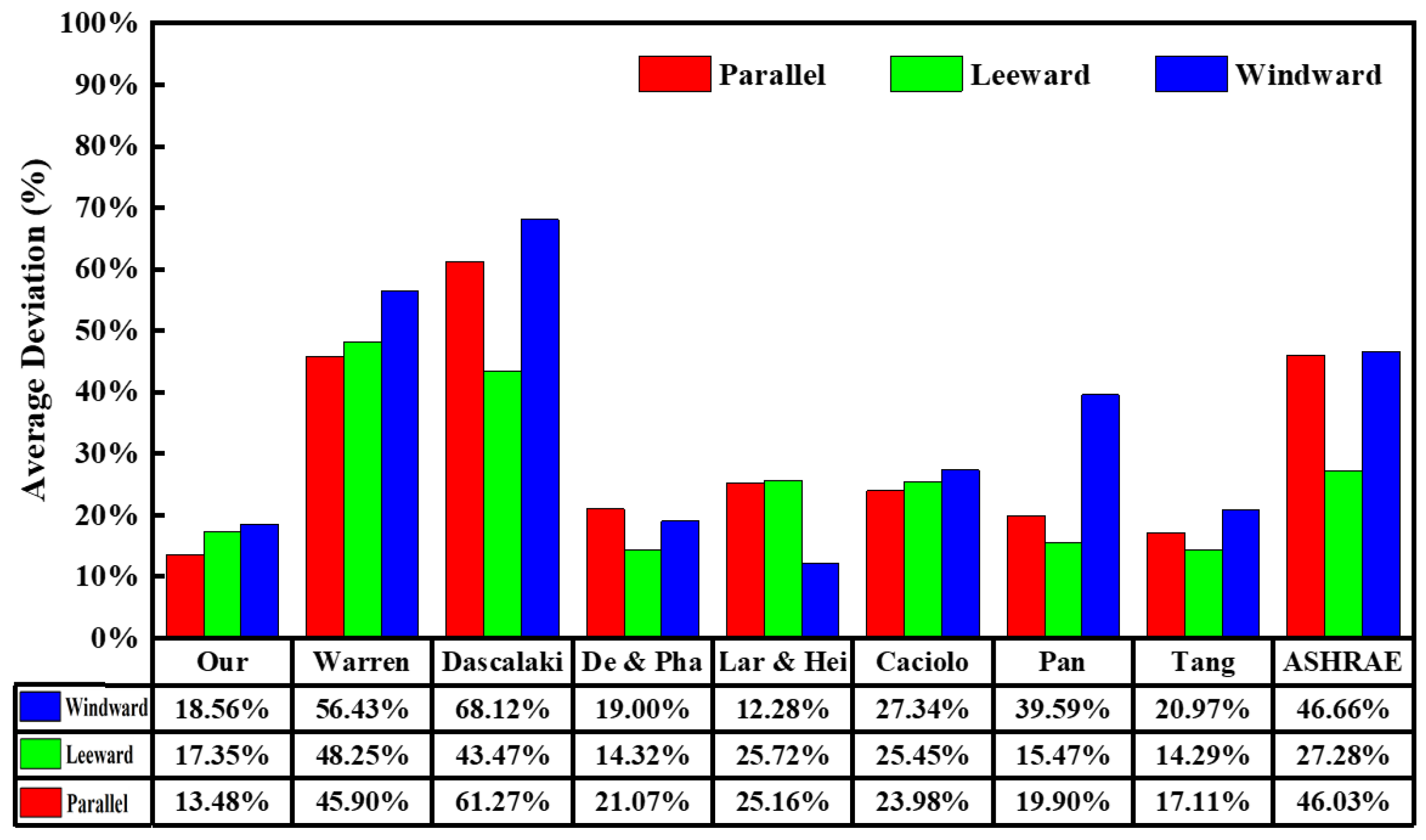

| No. | Dynasty | Main Room Size (m) | Aisle Size (m) | Niche Size (m) | Opening Size (m) | Location |
|---|---|---|---|---|---|---|
| 45 | Tang | 4.50 × 4.50 × 4.00 | 1.60 × 1.40 × 2.30 | 3.00 × 1.80 × 2.00 | 1.20 × 2.10 | 1st layer in south |
| 46 | Tang | 4.10 × 4.20 × 4.00 | 1.50 × 1.15 × 2.20 | 2.70 × 1.47 × 2.00 | 1.40 × 2.10 | 1st layer in south |
| Sensors | Vaisala HMP155A | CMP3 | Gill WindSonic 1405-PK-100 | Setra Model 261C |
|---|---|---|---|---|
| Test parameters | Temperature; relative humidity | Solar radiation | Wind speed; wind direction | Wind pressure |
| Method range | −80~60 °C; 0.8~100% | 300~2800 nm | 0~60 m/s | 0–25 Pa |
| Accuracy | ±0.12 °C; ±1% RH | <5% | ±2; ±3° | 0.4% |
| Sensors | Testo 175-H2 | TSI 7565 | Swema03+ |
|---|---|---|---|
| Test parameters | Temperature; relative humidity | CO2; CO; temperature; etc. | Wind speed; wind pressure; etc. |
| Method range | −20~70 °C; 0~100% | 0~5000 ppm | 0.05~3 m/s |
| Accuracy | ±0.6 °C; ±3% RH | ±3.0% or ±50 ppm | ±0.03 m/s or ±3% |
| Date | Cave | Case | (°C) | (m/s) | Wind Angle (°) | Air Change Rate (ACH) | ||
|---|---|---|---|---|---|---|---|---|
| January 2019 | 45 | 1 | −6.7 | −10.26 | 3.56 | 4.61 | 192 | 12.97 |
| 2 | −5.4 | −7.83 | 2.43 | 2.68 | 201 | 10.88 | ||
| 46 | 3 | −4.1 | −7.85 | 3.75 | 1.58 | 341 | 13.61 | |
| 4 | −4.2 | −7.87 | 3.67 | 1.75 | 350 | 13.20 | ||
| September 2019 | 45 | 5 | 23.5 | 24.99 | −1.49 | 2.46 | 26 | 9.46 |
| 6 | 25.0 | 26.73 | −1.73 | 2.35 | 25 | 10.73 | ||
| 46 | 7 | 26.2 | 28.71 | −2.51 | 2.20 | 26 | 10.92 | |
| 8 | 25.8 | 27.46 | −1.66 | 1.69 | 8 | 8.90 |
| Case | Wind Angle (°) | Wind Pressure Coefficient |
|---|---|---|
| 1 | 192 | −0.0359 |
| 2 | 201 | −0.0498 |
| 3 | 341 | −0.4621 |
| 4 | 350 | −0.3668 |
| 5 | 26 | 0.2503 |
| 6 | 25 | 0.3112 |
| 7 | 26 | 0.1809 |
| 8 | 8 | 0.1884 |
| Terrain | α | γ |
|---|---|---|
| Flat terrain with sparse trees or small buildings | 1.00 | 0.14 |
| Towns and suburbs | 0.85 | 0.20 |
| Urban, industrial or forest terrain | 0.67 | 0.25 |
| A large city with a dense cluster of tall buildings | 0.47 | 0.35 |
| Correlations | Deviation | ||
|---|---|---|---|
| Min (%) | Max (%) | Ave (%) | |
| Ours | 11.22 | 18.92 | 16.35 |
| Warren [30] | 39.44 | 64.53 | 50.44 |
| Dascalaki et al. [32] | 4.19 | 96.89 | 59.39 |
| De Gids and Phaff [34] | 13.33 | 29.40 | 18.61 |
| Larsen and Heiselberg [35] | 10.05 | 47.20 | 20.47 |
| Caciolo et al. [37] | 8.02 | 65.13 | 25.61 |
| Pan et al. [39] | 5.15 | 48.13 | 26.18 |
| Tang et al. [40] | 9.62 | 25.59 | 17.85 |
| Wind Direction | Wind Angle |
|---|---|
| Parallel | 0–15°, 165–195°, 345–360° |
| Leeward | 195–345° |
| Windward | 15–165° |
| Parameter | Opening | (°C) | (°C) | (°C) | (m/s) | Wind Angle (°) | Wang’s Experimental Ventilation Rate (m3/s) | Ventilation Rate Calculated by Our Correlation (m3/s) | Deviation (%) |
|---|---|---|---|---|---|---|---|---|---|
| Value | 1.5 × 2.4 | 5.0 | −0.32 | 5.32 | 3.14 | 251.79 | 0.12305 | 0.15069 | 22.46 |
Disclaimer/Publisher’s Note: The statements, opinions and data contained in all publications are solely those of the individual author(s) and contributor(s) and not of MDPI and/or the editor(s). MDPI and/or the editor(s) disclaim responsibility for any injury to people or property resulting from any ideas, methods, instructions or products referred to in the content. |
© 2023 by the authors. Licensee MDPI, Basel, Switzerland. This article is an open access article distributed under the terms and conditions of the Creative Commons Attribution (CC BY) license (https://creativecommons.org/licenses/by/4.0/).
Share and Cite
Zhang, J.; Yan, Z.; Zhang, Z.; Bi, W.; Yao, S. A New Correlation for Single-Sided Natural Ventilation Rate Based on Full-Scale Experimental Study in Mogao Grottoes, Dunhuang, China. Buildings 2023, 13, 1298. https://doi.org/10.3390/buildings13051298
Zhang J, Yan Z, Zhang Z, Bi W, Yao S. A New Correlation for Single-Sided Natural Ventilation Rate Based on Full-Scale Experimental Study in Mogao Grottoes, Dunhuang, China. Buildings. 2023; 13(5):1298. https://doi.org/10.3390/buildings13051298
Chicago/Turabian StyleZhang, Junjie, Zengfeng Yan, Zhengmo Zhang, Wenbei Bi, and Shanshan Yao. 2023. "A New Correlation for Single-Sided Natural Ventilation Rate Based on Full-Scale Experimental Study in Mogao Grottoes, Dunhuang, China" Buildings 13, no. 5: 1298. https://doi.org/10.3390/buildings13051298




